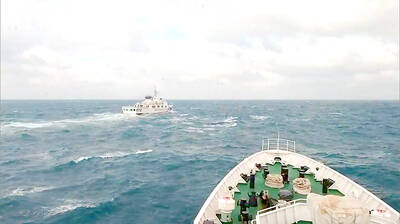The Ministry of Economic Affairs yesterday announced the government’s finalized feed-in tariff (FIT) for renewable energy, with the outcome showing milder pricing cuts than previously proposed.
The cap on the FIT for offshore wind energy over the next 20 years is set at NT$5.516 per kilowatt-hour (kWh), representing a 5.71 percent cut from last year’s NT$5.8498, as opposed to the much steeper 12.71 percent cut to NT$5.106 first proposed in November last year.
The new FIT pricing takes into account concerns voiced by offshore wind developers, who have said that a steep reduction would threaten the viability of projects, while pundits have questioned the perceived generosity of the government’s renewable energy purchasing price, Bureau of Energy Director-General Lin Chuan-neng (林全能) said at a news conference in Taipei.

Photo: Lin Ching-hua, Taipei Times
Following negotiations with developers, the renewable energy review committee acknowledged that offshore wind projects are more costly to build in Taiwan and must be supported with higher rates, Lin said.
Taiwan’s rougher seas permit fewer construction days, while the nation’s coastal ocean floors require more costly underwater jacket structures, he said.
Offshore wind developers in Taiwan have absorbed additional expenses not found in projects in other markets, such as conducting the initial survey and project evaluation and upgrading power grids, as well as offering incentives to affected fishers, Lin said.
While the government has agreed not to cancel a tiered FIT scheme in which energy purchases are higher over the first 10 years before tapering off in the next decade, the rate has been changed from 7-3 to 6-4.
The revised rate would ensure that offshore wind developers are committed to project operations for a minimum of 10 years and address the requirements of project financiers, Lin said.
The updated terms also raised the cap on offshore energy procurement from 3,600kWh to 3,750kWh to encourage the adoption of newer and bigger 8 megawatt (MW) turbines, instead of 4MW variants.
The government turned down developers’ request to forgo an annual cap on offshore wind energy procurement, Lin said, adding that the FIT rate would fall by 25 percent to NT$4.137 when output exceeds 4,200kWh and a further 50 percent to NT$2.758 beyond 4,500kWh.
“We will not extend a bigger reward to developers simply because the winds were more favorable in a certain year,” Lin said.
The latest FIT scheme does not include the additional cost burden of local content requirements, as local supply chain partners would get up to speed and become cost efficient with time, he added.
Lin said he is optimistic that the central government and the Changhua County Government can resolve an impasse that has prevented some developers from receiving project permits.
“We should be getting a definitive answer in the next two days,” Lin said, adding that the county government stated in an official letter to the bureau that it does not have the authority to approve projects.
The government stands behind its new FIT pricing, Deputy Minister of Economic Affairs Tseng Wen-sheng (曾文生) said, adding that the public can check how the rate was derived.
“The government remains committed to offshore wind energy and we urge developers to not give up on projects easily,” Tseng said.
The FIT rate for solar power and other renewable energy sources also saw lower reductions. Solar energy has a new biannual rate with a maximum reduction of 6.15 percent for the first half of the year and a maximum of 7.78 percent for the second half, compared with a 12.15 percent cut proposed before.

Auckland rang in 2026 with a downtown fireworks display launched from New Zealand’s tallest structure, Sky Tower, making it the first major city to greet the new year at a celebration dampened by rain, while crowds in Taipei braved the elements to watch Taipei 101’s display. South Pacific countries are the first to bid farewell to 2025. Clocks struck midnight in Auckland, with a population of 1.7 million, 18 hours before the famous ball was to drop in New York’s Times Square. The five-minute display involved 3,500 fireworks launched from the 240m Sky Tower. Smaller community events were canceled across New Zealand’s

The Ministry of Foreign Affairs (MOFA) yesterday said it is closely monitoring developments in Venezuela, and would continue to cooperate with democratic allies and work together for regional and global security, stability, and prosperity. The remarks came after the US on Saturday launched a series of airstrikes in Venezuela and kidnapped Venezuelan President Nicolas Maduro, who was later flown to New York along with his wife. The pair face US charges related to drug trafficking and alleged cooperation with gangs designated as terrorist organizations. Maduro has denied the allegations. The ministry said that it is closely monitoring the political and economic situation

‘SLICING METHOD’: In the event of a blockade, the China Coast Guard would intercept Taiwanese ships while its navy would seek to deter foreign intervention China’s military drills around Taiwan this week signaled potential strategies to cut the nation off from energy supplies and foreign military assistance, a US think tank report said. The Chinese People’s Liberation Army (PLA) conducted what it called “Justice Mission 2025” exercises from Monday to Tuesday in five maritime zones and airspace around Taiwan, calling them a warning to “Taiwanese independence” forces. In a report released on Wednesday, the Institute for the Study of War said the exercises effectively simulated blocking shipping routes to major port cities, including Kaohsiung, Keelung and Hualien. Taiwan would be highly vulnerable under such a blockade, because it

UNRELENTING: China attempted cyberattacks on Taiwan’s critical infrastructure 2.63 million times per day last year, up from 1.23 million in 2023, the NSB said China’s cyberarmy has long engaged in cyberattacks against Taiwan’s critical infrastructure, employing diverse and evolving tactics, the National Security Bureau (NSB) said yesterday, adding that cyberattacks on critical energy infrastructure last year increased 10-fold compared with the previous year. The NSB yesterday released a report titled Analysis on China’s Cyber Threats to Taiwan’s Critical Infrastructure in 2025, outlining the number of cyberattacks, major tactics and hacker groups. Taiwan’s national intelligence community identified a large number of cybersecurity incidents last year, the bureau said in a statement. China’s cyberarmy last year launched an average of 2.63 million intrusion attempts per day targeting Taiwan’s critical